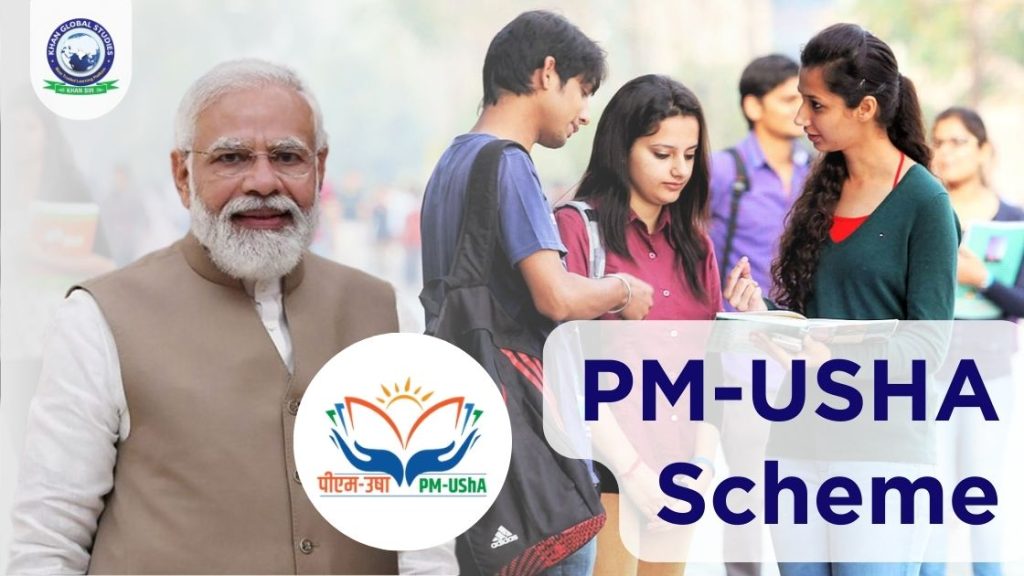PM-USHA is a centrally sponsored scheme under the Ministry of Education to enhance the quality and access to higher education across the country. PM-USHA scheme aims to improve the curriculum, teachers’ training, infrastructure, accreditation and employability. Focus on ensuring equity, access and excellence in higher education in states and union territories. The amount allocated for the PM-USHA scheme for 2023-24 to 2025-26 is ₹12,926.10 crore.
PM-USHA Scheme
PM-USHA is the successor program of Rashtriya Uchchatar Shiksha Abhiyan (RUSA), which was launched in 2013. The objective of the scheme is to promote equity, access and inclusion in higher education, improve teaching quality and emphasize accreditation of colleges and universities. , While 60% of the funds for the scheme will be provided by the central government, states will contribute the remaining 40%.
The funds are being released under two components of the scheme – Rs 100 crore is being provided for Multidisciplinary Education and Research Universities and Rs 20 crore is being provided for strengthening the universities. At least 26 state universities across the country have been selected under the former category, while 52 universities will be funded through the latter.
Background of the PM-USHA program
- The RUSA (Rashtriya Uchchatar Shiksha Abhiyan) was initially introduced as a centrally sponsored scheme aimed at providing funding to educational institutions in states and union territories.
- The inaugural phase of the scheme began in 2013, followed by its second phase in 2018.
- In line with the goals set out in the National Education Policy, the RUSA initiative has been revamped and is now known as the Pradhan Mantri Uchchtar Shiksha Abhiyan (PM-USHA).
The objective of PM-USHA
- Through this, the focus has been on improving the employability of graduates.
- Funding for market-linked courses, industry exposure, and student incentives.
- Internship, etc.; Strictly track and monitor the employability outcomes of HEIs.
- To introduce skill-based education for students and identify important skills.
- Teaching interventions in higher education institutions to leverage technology.
- promoting access and quality; Assistance to institutions for improvement in NAAC.
- Recognition grade, greater emphasis on quality initiatives, higher promotion.
- Adoption of e-learning/virtual learning, tracking the outputs/outcomes of the scheme.
The Main Issue
- PM-USHA is a scheme of the Ministry of Education to improve the quality of higher education in state universities.
- The plan envisages an outlay of Rs 12,926.10 crore between 2023-24 and 2025-26, achieving equity through curriculum and program changes, teacher training, physical and digital infrastructure, accreditation and enhancing employability Will be able to go. Access and inclusion can be ensured. Provides.
- Kerala, Tamil Nadu and West Bengal are among the 14 states and union territories that have not yet signed a key memorandum of understanding (MoU) with the Union education ministry mandating the implementation of the National Education Policy.
- Several states have raised concerns over the MoU, given that 40% of the PM-USHA budget is to be borne by the states and no additional funds will be earmarked for NEP reforms.
- The Center says it is holding discussions with the disagreeing states to resolve the differences.
- According to University Grants Commission Chairman M. Jagadish Kumar, currently, 22 states/UTs have signed the MoU.
Challenges Before the Higher Education System
The NEP has identified some of the major problems currently facing the higher education system in India, which are:
- A seriously fragmented higher educational ecosystem; with less emphasis on the development of cognitive skills and learning outcomes
- The rigid separation of subjects, early specialization, and limiting students to narrow areas of study
- limited access to some higher education institutions teaching in local languages, particularly in socio-economically disadvantaged areas
- limited teacher and institutional autonomy
- inadequate mechanisms for competency-based career management and advancement of faculty and institutional leaders
- The low emphasis on research in most universities and colleges, and the lack of competitive peer-reviewed research funding across all disciplines
- sub-optimal governance and leadership of HEIs
- an ineffective regulatory system; And large affiliated universities result in lower standards of graduate education.
Pillars of PM-USHA scheme
The main pillars of the plan are:
Equity, Access and Inclusion
- The scheme focuses on equality initiatives and gender inclusion by providing adequate opportunities to disadvantaged groups, and it promotes the inclusion of women, minorities, SC/ST/OBC and people with disabilities in higher education, thereby increasing the overall enrolment. The reform will help in increasing the ratio (GER).
- The language barrier for learners should be removed, and multilingualism as a medium of instruction, such as mother tongue/local and regional languages, should be promoted, increasing access among different curricula and providing learners with artistic, creative, cultural and educational opportunities. Opportunity should be provided.
To develop quality teaching and learning process
- PM-USHA will provide facilities to upgrade the physical and digital infrastructure of the institution and convert single-stream higher education institutions (HEIs) into multiple-stream institutions.
- To improve the quality of learning, the Multiple Entry and Exit System, Choice-Based Credit System (CBCS), and Academic Bank of Credit (ABC) will all be rapidly supported and prioritized under PM-USHA.
Improvement in recognition and accreditation of unrecognized institutions
- National Assessment and Accreditation Council (NAAC), is a national accrediting agency that ensures the overall performance and quality of HEIs.
- NAAC conducts assessment and accreditation of HEIs such as colleges, universities or other recognized institutions to gain an understanding of the ‘quality status’ of the institution.
ICT-based digital infrastructure
- ICT efforts like the National Digital Library, DigiLocker, e-Shodh Sindhu and virtual laboratories will be used and students will be given a virtual platform for their learning opportunities.
- To enhance teacher capacity in ICT tools, the scheme will also focus on the faculty development programme.
- With the implementation of ICT digital infrastructure under PM-USHA, the institutions will be encouraged to provide Wi-Fi facilities, smart classrooms and virtual labs in the institute campuses.
Enhancing employability through multi-disciplinarity
- Collaboration between industry and academia is important to catalyze innovation and growth in career building. PM-USHA will encourage HEIs to link up with industry and market to strengthen skills, innovation and employability.
- PM-USHA will focus on setting up employment cells to create links between education, industry and market.
- It also ensures rigorous tracking and monitoring of employability through market-linked courses and emphasizes the development of cognitive skills and learning outcomes.
The National Education Policy 2020 (NEP) is a guiding force in laying the foundation of PM-USHA.
Institutional structure of PM-USHA
PM-USHA will be implemented and monitored through an institutional structure of bodies with clearly defined roles and powers at the Central, State and institutional levels.
The central level structure consists of four bodies:
- National Mission Authority (NMA) is headed by the Honorable Minister of Education, Government of India
- The Project Approval Board (PAB) is chaired by the Secretary (Higher Education) to the Government of India.
- National Project Directorate (NPD)
- Technical Support Group (TSG)
The state-level structure consists of three bodies:
- State Higher Education Council (SHEC)
- State Project Directorate (SPD)
- State Technical Support Group (State-TSG)
At the institutional level, the project is managed by two bodies:
- Board of Governors (BOG)
- Project Monitoring Unit (PMU)



